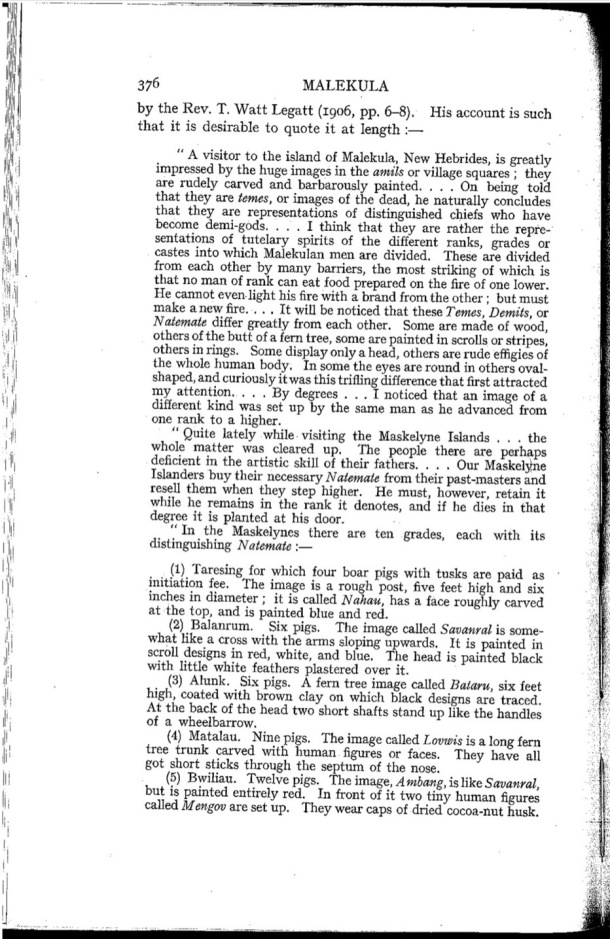|
|  [Note: this transcription was produced by an automatic OCR engine]
ii l 376 MALEKULA
by the Rev. T. Watt Legatt (1906, pp. 6-8). I-lis account is such
a ‘ that it is desirable to quote it at length :—
| ,.
A visitor to the island of Malekula, New Hebrides, is greatly
impressed by the huge images in the amils or village squares ; they
are rudely carved and barbarously painted. . . . On being told
that they are temes, or images of the dead, he naturally concludes
that they are representations of distinguished chiefs who have
become demi-gods. . . . I think that they are rather the repre-
sentations of tutelary spirits of the different ranks, grades or
castes into which Malekulan men are divided. These are divided
from each other by many barriers, the most striking of which is
that no rn.al1 of rank can eat food prepared on the ï¬Åre of one lower.
He cannot evenlight his ï¬Åre with a brand from the other ; but must
make a new ï¬Åre. . . . It will be noticed that these Tamas, Demits, or
Nalematz differ greatly from each other. Some are made of wood,
others of the butt of a tern tree, some are painted in scrolls or stripes,
others in rings. Some display only a head, others are rude eï¬Åigies oi
the whole human body. In some the eyes are round in others oval-
shaped, and curiously it was this trifling difference that ï¬Årst attracted
my attention. . . . By degrees . . . I noticed that an image of a
diflerent kind was set up by the same man as he advanced from
one rank to a higher.
“ Quite lately while visiting the Maskelyne Islands . . . the
whole matter was cleared up. The people there are perhaps
deï¬Åcient in the artistic skill of their fathers. . . . Our Maskelyne
Islanders buy their necessary Nalzmale from their past-masters and
resell them when they step higher. He must, however, retain it
while he remains in the rank it denotes, and if he dies in that
degree it is planted at his door.
“ In the Maskelynes there are ten grades, each with its
distinguishing Natemate :—
(1) Taresing ior which four boar pigs with tusks are PAID as
initiation fee. The image is a rough post, ï¬Åve ieet high and six
inches in diameter ; it is called Nahau, has a face roughly can/ed
at the top, and is painted blue and red.
(2) Balanrum. Six pigs. The image called Savarmzl is some-
what like a cross with the arms sloping upwards. It is painted in
scroll designs in red, white, and blue. The head is painted black
with little white feathers plastered over it.
(3) Alunk. Six pigs. A fern tree image called Bataru, six leet
high, coated with brown clay on which black designs are traced.
At the back of the head two short shafts stand up like the handles
of a wheelbarrow.
(4) Matalau. Nine pigs. The image called Lauwis is a long fern
tree trunk carved with human ï¬Ågures or faces. They have all
got short sticks through the septum of the nose.
(5) Bwiliau. Twelve pigs. The image, Amlumgjslike Sawmral,
but is painted entirely red. In front of it two tiny human ï¬Ågures
called M engov are set up. They wear caps of dried cocoa-nut husk.
‘ l
‘ .1.
|